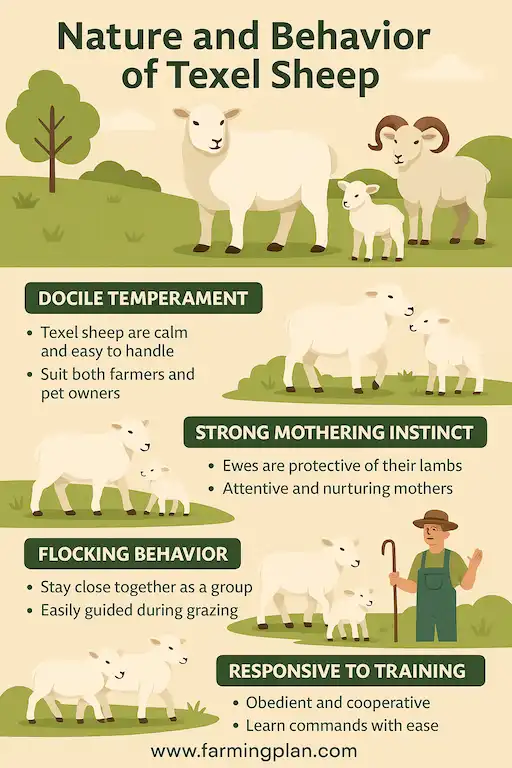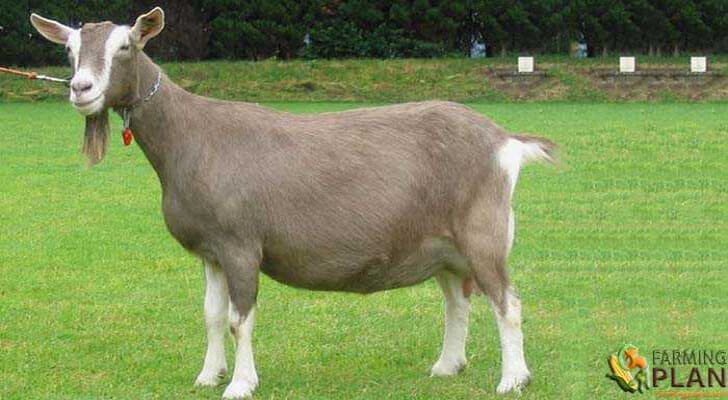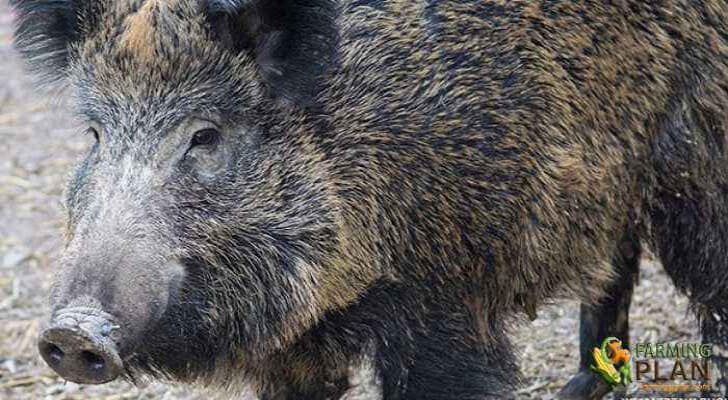Texel sheep are one of the most popular breeds in modern sheep farming. Known for their muscular build and lean meat, Texel sheep are a top choice for farmers, breeders, and pet owners. This breed stands out because of its strong genetics, low carcass fat, and friendly nature. Whether raising Texel lambs for meat or building a healthy ewe flock, understanding this breed can help you make wise choices. In this guide, you’ll learn everything about Texel sheep—from their history to step-by-step farming tips—all in a simple and friendly way.

Texel Sheep History and European Roots
Texel sheep come from the island of Texel in the Netherlands. Farmers there wanted a strong, easy-to-raise sheep that gave good meat. So, they started breeding local sheep with strong, muscular ones from Continental Europe. Over time, they created the Texel breed—a challenging, muscular sheep known for its lean meat.
In the early 1800s, this new breed of sheep caught the attention of other countries. British farmers helped improve it more by adding breeds with better wool and stronger legs. Later, Texel sheep were introduced to the American sheep industry after passing a five-year quarantine. This rule helped keep the breed healthy and free from disease.
Today, Texel sheep are part of the national flock in many countries, and the Sheep Society continues to support their development. Thanks to their strength and quality, Texels are now used worldwide in both small farms and big market operations.
Characteristics
Texel sheep are known for their strong, solid bodies. They are medium-sized but packed with muscle. Their legs are straight and sturdy, and their backs are broad. This shape helps them grow fast and produce high-quality meat. Farmers love them because they are generously built sheep that stay healthy and active.
One special thing about this breed is the myostatin gene. This gene helps them grow muscles without adding much fat, so Texans have less carcass fat than other breeds. Their loin-eye area and leg score are often better, making them top picks for meat production.
Even though they are primarily raised for meat, Texel sheep also have decent wool. Their fleece weights are good, and the wool is usually medium-grade. It meets standards like the USDA Wool Grade and the British Wool Marketing Board. The wool is mostly clean and white, but sometimes you may find black fibres, which are less common.
Because of their body shape, Texel sheep are often called muscled sheep or muscular sheep. This distinguishes them from other domestic sheep and even from Hare sheep breeds.
Nature and Behavior of Texel Sheep

The Texel sheep variety demonstrates a peaceful nature and simple handling capabilities. Due to their sociable stock personality, Texel sheep serve both farmers and pet owners well. The sheep species maintains its composure under all circumstances, so it is frequently chosen for use in family farming operations and small-scale establishments.
Mothers demonstrate protective and caring behaviours toward their infants throughout a whole flock. Mother Texel sheep assist their newly born lambs in standing up and starting to feed just after delivery. These natural mothering actions both reduce stress levels and produce better health outcomes for the lamb. When they reach adulthood, Texel female lambs naturally develop into tender and reliable maternal caregivers.
The Texel ewes like to maintain proximity to other members of their group. Their habit of staying close ensures flocking behaviour allows easy control in pasture management. All sheep in that area will automatically move when one sheep begins to walk. Farmers appreciate this behaviour when they utilize the fields for grazing activities. Through basic training, novice owners can smoothly direct their Texel sheep.
You will experience excellent responsiveness among your ram lambs, ewes and Texel lambs, which you raise for meat production. Sheep of this breed stand out as one of the most manageable sheep breeds because they easily learn instructions and demonstrate peaceful characteristics.
What Texel Sheep Eat and Nutritional Value
A nutritious diet is key for Texel sheep to develop proper strength and healthy growth. Protein-rich foods, energy, and minerals must make up their daily diet. Farmers give Texel sheep combined diets of different types of hay along with grass and grain feed. The proper diet of these foods enables Texels to develop muscle mass while maintaining appropriate body weight.
For the first period, Texel lambs require steady milk consumption. After spending several weeks on this diet, the sheep will begin eating soft hay and grains. Orphan lambs or those with weak mothers get enough milk through a lamb bar, according to farming practices. Continual feeding of food helps lambs develop into quick-growing, profitable animals.
As they grow, Texels eat more grass and less grain. Good pasture means stronger, healthier sheep. It also improves lamb meat production and quality. Because they build lean muscle, Texels are known for producing wholesome and tasty lean lamb products.
Their milk can also be used to make nutritious sheep cheese. While meat is the primary goal, some small farms love using Texel milk for dairy treats. So, food matters for Texel’s—what they eat shapes their health and meat quality.
Read More: Adal Sheep: Most Interesting Breed in the World
Usage and Importance in Sheep Farming
Texel sheep are incredibly valuable in sheep farming, especially for those focused on lamb meat production. Farmers love them for their ability to produce high-quality, lean lamb products. Texels are known for their fast-gaining nature, which means they reach market weight quickly without accumulating excess fat. This makes them ideal for crossbred market-lamb operations where farmers aim to produce lambs that grow rapidly and efficiently.
Not only do they produce excellent lamb meat, but Texels also have a strong genetic influence. When Texel rams breed with other ewes, like American black-face-sired or black-faced lambs, they pass on traits like muscular sheep bodies and low-fat carcasses. This has made them a top choice for improving meat quality in the global market. Texel-sired lambs often fetch a higher price due to their excellent meat yield and quality.
Though they’re often used for meat, Texels have a role in wool production. Their wool may not be the primary focus, but they produce decent fleece weights, often medium-grade. Texel wool is sold at places like the British Wool Marketing Board, and products like blankets and textiles are in demand.
The Texel breed has become a cornerstone in modern sheep farming, especially for those looking to emphasize lamb meat over wool. Their low carcass fat, muscular build, and efficient growth make them an essential breed in both commercial farming and smaller operations.
Unique Features That Make Texel Sheep Stand Out

Texel sheep are known for their rigid bodies and low-fat meat. Their myostatin gene makes them unique from other sheep breeds because it enables them to grow stiff muscles without accumulating additional fat. This genetic component results in low carcass fat, a valuable trait in the meat industry. Texels produce high-yielding lambs and lean lamb products, a preference for farmers wishing to make good meat.
Texels also have a sizeable loin-eye area, which indicates excellent meat quality. This is where the lamb’s meat is most tender, and the larger the loin-eye area, the more cuts of high-quality meat the butcher will have. Leg score is another thing farmers look at, which shows how strong the sheep’s legs are in carrying weight. Texels have excellent leg scores, so they are strong and durable.
Texels are not quite as good for production as other breeds, but their wool is still usable. Their fleece weights are considered medium-grade and generally sold commercially. Although Texels do not produce bulk wool like many breeds, their wool meets industry standards like the USDA Wool Grade and British Wool Marketing Board.
Texel sheep also have a unique colour feature: they are generally white, but occasionally, you can see black hairs in their fleece, especially black-faced ram lambs. This is an unusual feature and gives the breed an interesting feature. With all these unique features, Texel’s are one of the top breeds for meat and wool production, providing a fine balance for commercial and small farmers.
Read More: Bergamasca Sheep: Farm With Little Money
Health Challenges and Prevention Tips
Texel sheep are generally healthy, but as with any breed, they will be prone to a few health problems. Knowing how to avoid and cure these ailments is crucial in keeping your flock healthy and in high production.
Common Health Problems in Texel Sheep
One of the most common health issues with Texel sheep is foot rot, a bacterial infection of the hooves. It can result in lameness and pain, stunted growth, and meat production. Foot rot can be prevented by trimming the hooves regularly and providing dry and clean bedding. If limping or swelling of the hooves is noticed, consult a veterinarian for treatment.
The second issue is parasite control, particularly in young Texel lambs. Internal parasites like worms make lambs weaker and cause growth issues. Deworming and pasture rotation are great ways of controlling parasites. Proper grazing management also avoids over-exposure to parasites and supplies lambs with the necessary nutrition.
Read More: Border Cheviot Sheep: Farm From Scratch
Preventing Defective Gene Expressions
Texels possess the myostatin gene’s muscular stature, but sometimes a defective gene may cause such issues as over-sized muscles or difficulty lambing. The solution to preventing this lies in selective breeding stock and sound attention to genetics. Always get guidance from breeders familiar with the gene and its effects on the sheep.
Health Maintenance Tips
Keep an eye on newborn lambs right from birth to reduce the risk of lamb losses. Make sure they stand, nurse, and bond with their mothers. If a lamb can’t feed, use a lamb bar or bottle-feed it to ensure it gets the nutrition it needs. Fresh water and a balanced diet will help them grow into fast-gaining, healthy Texel lambs.
Regular vaccinations and good pasture management are essential to keeping your flock healthy. By staying on top of these health issues, you can ensure your Texel sheep remain vigorous, active, and productive.
“Start With A Small, Manageable Flock And Build Up As You Gain Experience. Focus On Quality Genetics Over Quantity For The Best Lamb Meat Returns.”
Step-by-Step Guide for Texel Sheep Farmers and Pet Owners
Whether you’re a seasoned farmer or a first-time pet owner, raising Texel sheep can be a rewarding experience. From birth to maturity, here’s a simple guide to help you care for your Texel flock.
Step 1: Preparing the Flock Environment
The first thing you need is a suitable space for your Texel sheep. They need clean, dry areas to graze and sleep. Ensure your pasture is free of parasites and has plenty of fresh grass. This is essential for their health and meat production. You’ll also need a safe shelter to protect them from extreme weather conditions.
Step 2: Caring for Newborn Lambs
Newborn lambs are vulnerable, so it’s essential to monitor them closely. Ensure they are standing and nursing within the first hour of birth. If Texel lambs struggle to nurse, use a lamb bar or bottle-feed them to ensure they get the necessary nutrients. Keeping the lamb warm and dry is essential for their survival and growth.
Step 3: Nutrition and Diet
Texel sheep thrive on a balanced diet. For Texel lambs, start with milk and gradually introduce soft hay and grains. Once they’re older, they can graze on grass and eat more grains. Provide plenty of fresh water, and make sure your pasture offers enough nutrients to support fast-growing growth. A proper diet will help them develop into high-yield lambs with excellent meat quality.
Step 4: Regular Health Checks
Keep an eye on your Texels’ health. Check their hooves regularly to prevent foot rot and trim them when necessary. Track their vaccinations and deworming schedules to avoid parasite issues. Regular health visits from a vet will help identify any potential problems early on.
Step 5: Breeding and Genetic Considerations
When it’s time to breed, choose healthy ram lambs and ewe flock members that exhibit the strong traits you want, such as muscle growth and low carcass fat. Texel-sired lambs tend to produce lean lamb products, so breeding them with other sheep breeds that complement these traits can improve meat quality.
Step 6: Managing Wool Production
Although Texel sheep are mainly raised for meat, they still produce medium-grade fleece. Regularly shear your sheep to keep them comfortable, especially during warmer months. Wool from Texels can be sold or used for personal items, making it an additional source of income.
FAQ
What makes Texel sheep unique?
Thanks to the myostatin gene, Texel sheep are known for their muscular build and low-fat meat. They produce lean lamb products with excellent meat quality, making them a top choice for farmers who emphasize lamb meat production.
What do Texel sheep eat?
Texel sheep thrive on a diet of grass, hay, and grains. Texel lambs start with milk and gradually move to solid foods. A balanced diet ensures they grow into fast-gaining and high-yield lambs. Always provide plenty of fresh water and ensure access to good pasture for optimal health.
How do you prevent common health issues in Texel sheep?
Regular hoof care, such as trimming, can help prevent foot rot. Texel’s should also be regularly dewormed, and their pasture rotated to reduce parasite risk. Watching for early signs of illness and seeking timely veterinary care is key to keeping them healthy.
Are Texel sheep suitable for wool production?
Texel sheep are primarily raised for meat production but produce medium-grade wool. While not known for bulk wool production, Texel fleece can still be used for textiles and sold at places like the British Wool Marketing Board.
Can Texel sheep be raised on small farms?
Yes! Texel sheep are known for their calm and friendly nature, making them easy to manage on small farms. They adapt well to different farming conditions and can be a good fit for farmers interested in meat and limited wool production.
Conclusion
Texel sheep are an excellent choice for farmers and pet owners who want to raise strong, healthy sheep with high-quality lamb meat production. With their muscular build, friendly temperament, and fast growth, they bring a lot of value to any flock. Following the right care guidelines, including proper nutrition, health management, and breeding practices, ensure your Texel sheep thrive and continue to produce high-yield lambs and lean lamb products. Whether you’re focused on meat production or looking for a reliable and adaptable breed for your farm, Texel’s offer plenty of benefits that make them a top contender in sheep farming.


